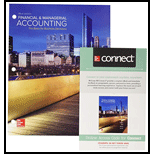
a.
Compute
a.
Explanation of Solution
DuPont model: It is a model which allows the analyst to analyse a company’s performance using the return on sale and capital turnover ratios. This ratio analyses the company’s performance by considering the earnings per sales dollar and the sales generated per capital invested. DuPont model equation is as follows:
Determine the return on investment for each department.
| Particulars | Golf courses | Restaurants | Pro Shops |
Complex TCG (Note 1) |
| Return On Sales | ||||
| Operating earnings (A) | $2,000,000 | $800,000 | $300,000 | $3,100,000 |
| Sales revenue (B) | $16,000,000 | $2,000,000 | $500,000 | $18,500,000 |
| Return on sales (1) | 12.5% | 40% | 60% | 16.8% |
| Capital Turnover | ||||
| Sales revenue (A) | $16,000,000 | $2,000,000 | $500,000 | $18,500,000 |
| Average investment (B) | $10,000,000 | $3,200,000 | $1,000,000 | $14,200,000 |
| Capital Turnover (2) | 160% | 62.5% | 50% | 130% |
| Return On Investment | ||||
| Operating earnings (A) | $2,000,000 | $800,000 | $300,000 | $3,100,000 |
| Average investment (B) | $10,000,000 | $3,200,000 | $1,000,000 | $14,200,000 |
| Return on investment | 20% | 25% | 30% | 21.8% |
Table (1)
Note: The ratios of all three departments are added together in Complex TCG column.
As per Table (1), the return on sales for the Department Golf courses is 20% which is the lowest among other departments and the capital turnover for Department Golf course is 160% which is highest among other departments. This is because of the heavy investment made in the assets of Department Golf courses as compared among other departments.
b.
Determine the ROI of the investment in the new display cases and explain the impact of the investment in the ROI of Department Pro shops. Explain whether the manager of Department Pro shops would be motivated to undertake such investment.
b.
Explanation of Solution
Return on investment (ROI): This financial ratio evaluates how efficiently the assets are used in earning income from operations. So, ROI is a tool used to measure and compare the performance of a units or divisions or a companies. The formula for ROI is as follows:
Determine the ROI of the new display cases.
Thus, the ROI of the new display cases is 12%.
Determine the impact of the new display cases on the ROI of Department Pro shops.
The new return on investment (ROI) is 29.14%. The manager of Department Pro shops would not be motivated to undertake the investment because the ROI of Department Pro shops would decrease to 29.14%.
c.
Calculate the residual income for each department if the minimum required return for the Complex TCG is 16 percent and explain the impact of the investment in (b) on the Pro Shop’s residual income.
c.
Explanation of Solution
Residual income: Residual income is the excess of income over the minimum acceptable return on average capital invested. The minimum
Determine the residual income (loss) for each department.
| Particulars | Golf courses | Restaurants | Pro Shops |
| Operating earnings (A) | $2,000,000 | $800,000 | $300,000 |
| Minimum acceptable return (B) | 16% | 16% | 16% |
| Average investment (C) | $10,000,000 | $3,200,000 | $1,000,000 |
| Minimum acceptable return on average capital invested (D) | $1,600,000 | $512,000 | $160,000 |
| Residual income (E) | $400,000 | $288,000 | $140,000 |
Table (2)
Thus, the residual income (loss) of Department Golf courses, Department Restaurants, and Department Pro Shops are $400,000, $288,000, and $140,000 respectively.
Determine the impact of the new display cases on the residual income of Department Pro Shops.
If the Department Pro Shops buys the new display cases, its residual loss will be reduced by ($2,000).
Want to see more full solutions like this?
Chapter 25 Solutions
Gen Combo Looseleaf Financial And Managerial Accounting; Connect Access Card
- On March 1, 20X1, your company,which uses Units-of-Production (UOP) Depreciation, purchases a machine for $300,000.arrow_forwardPlease provide the accurate answer to this general accounting problem using valid techniques.arrow_forwardI am searching for the right answer to this financial accounting question using proper techniques.arrow_forward
- Please explain the solution to this general accounting problem with accurate principles.arrow_forwardI am searching for the correct answer to this general accounting problem with proper accounting rules.arrow_forwardi will give unhelpful.blurr image please comment i will write values. please dont Solve with incorrect values otherwise unhelpful.arrow_forward

 AccountingAccountingISBN:9781337272094Author:WARREN, Carl S., Reeve, James M., Duchac, Jonathan E.Publisher:Cengage Learning,
AccountingAccountingISBN:9781337272094Author:WARREN, Carl S., Reeve, James M., Duchac, Jonathan E.Publisher:Cengage Learning, Accounting Information SystemsAccountingISBN:9781337619202Author:Hall, James A.Publisher:Cengage Learning,
Accounting Information SystemsAccountingISBN:9781337619202Author:Hall, James A.Publisher:Cengage Learning, Horngren's Cost Accounting: A Managerial Emphasis...AccountingISBN:9780134475585Author:Srikant M. Datar, Madhav V. RajanPublisher:PEARSON
Horngren's Cost Accounting: A Managerial Emphasis...AccountingISBN:9780134475585Author:Srikant M. Datar, Madhav V. RajanPublisher:PEARSON Intermediate AccountingAccountingISBN:9781259722660Author:J. David Spiceland, Mark W. Nelson, Wayne M ThomasPublisher:McGraw-Hill Education
Intermediate AccountingAccountingISBN:9781259722660Author:J. David Spiceland, Mark W. Nelson, Wayne M ThomasPublisher:McGraw-Hill Education Financial and Managerial AccountingAccountingISBN:9781259726705Author:John J Wild, Ken W. Shaw, Barbara Chiappetta Fundamental Accounting PrinciplesPublisher:McGraw-Hill Education
Financial and Managerial AccountingAccountingISBN:9781259726705Author:John J Wild, Ken W. Shaw, Barbara Chiappetta Fundamental Accounting PrinciplesPublisher:McGraw-Hill Education





